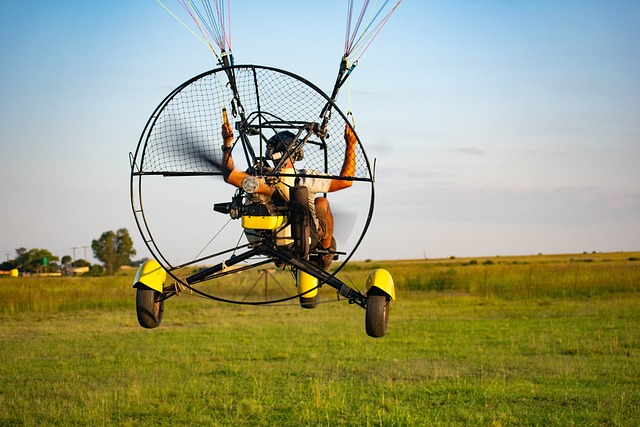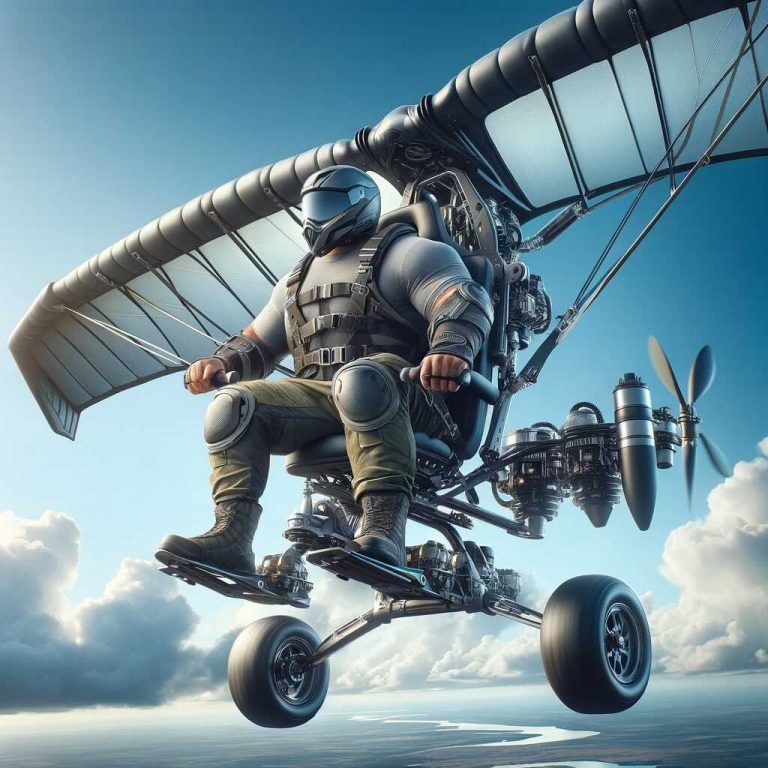Paramotoring, also known as powered paragliding, is an exhilarating sport that allows individuals to soar through the skies with a motorized paraglider. However, before taking to the skies, it’s important to understand what equipment is needed to fly a paramotor safely and effectively.
To fly a paramotor, you need several key pieces of equipment. The primary equipment is the paramotor itself, which includes the engine, propeller, harness, cage, and fuel tank. You’ll also need a wing, which is the canopy that provides lift and allows you to stay aloft. Other essential equipment includes a helmet to protect your head, a communication system to stay in contact with other pilots or ground crew, and a GPS to track your location and provide navigation information. Finally, it’s crucial to receive proper training and certification before taking to the skies and to comply with all relevant regulations and legal considerations in your area.
However, in this post, I’ll cover the essential equipment needed to fly a paramotor, including the paramotor itself, the wing, and other important equipment such as a helmet, communication system, and GPS. I’ll also discuss the importance of training and certification, as well as legal considerations to keep in mind. Whether you’re a beginner or an experienced pilot, this guide will provide you with the information you need to take to the skies with confidence.
The Paramotor
The paramotor is the motorized unit that provides thrust to the paraglider wing, allowing the pilot to take off and maintain altitude in the air. Here are the key components of a paramotor:
- Engine: The engine is the heart of the paramotor and provides the power to propel the aircraft. Most paramotors use a two-stroke engine, although four-stroke engines are also available. The engine’s power is measured in horsepower (hp) or cubic centimeters (cc).
- Propeller: The propeller is attached to the engine and converts the engine’s power into thrust. The size and pitch of the propeller determine the paramotor’s performance, such as speed and climb rate.
Harness: The harness connects the pilot to the paramotor and distributes the weight of the equipment across the pilot’s body. A comfortable and properly fitted harness is crucial for safe and enjoyable flights.
- Cage: The cage surrounds the propeller to protect the pilot and bystanders from the rotating blades. It also provides structure and support to the paramotor.
- Fuel Tank: The fuel tank holds the gasoline that powers the engine. The size of the fuel tank depends on the paramotor’s engine size and the length of the flight.
Having a reliable and well-maintained paramotor is essential for safe and enjoyable flights. It’s important to choose a paramotor that is appropriate for your experience level, flying style, and weight, and to regularly inspect and maintain the equipment to ensure its continued airworthiness.
The Wing
The wing is the parachute-like canopy that provides lift and allows the pilot to stay aloft. Here are the key components of a paramotor wing:
- Canopy: The canopy is the wing’s fabric surface that captures the air and provides lift. The size and shape of the canopy determine the wing’s performance, such as speed, glide ratio, and stability.
- Lines: The lines are the cords that connect the canopy to the pilot and the risers. The number and length of lines can vary depending on the wing’s design.
Risers: The risers are the straps that connect the lines to the harness and allow the pilot to control the wing’s angle of attack, speed, and direction.
- Brake Toggles: The brake toggles are the handles that control the trailing edge of the wing and allow the pilot to slow down or speed up the wing.
Choosing the right wing is critical for safe and enjoyable flights. The wing’s size, shape, and design should be appropriate for the pilot’s weight, skill level, and flying style. It’s important to regularly inspect and maintain the wing to ensure its continued airworthiness, and to follow the manufacturer’s instructions for proper care and storage.
Other Equipment
In addition to the paramotor and wing, several other pieces of equipment are essential for safe and enjoyable flights. Here are some examples:
- Helmet: A helmet is a critical piece of safety equipment that protects the pilot’s head in case of an accident or impact. It’s important to choose a helmet that fits properly and is designed for paramotoring or other aerial sports.
- Communication System: A communication system allows the pilot to communicate with other pilots or ground crew during the flight. This can be important for safety reasons or for coordinating with other pilots in a group.
GPS: A GPS (Global Positioning System) can be a useful tool for navigation, tracking, and safety. It can help the pilot determine their location, altitude, speed, and direction, and can also provide information about weather conditions and airspace restrictions.
- Reserve Parachute: A reserve parachute is a backup parachute that is designed to deploy in cases of an emergency, such as a canopy malfunction or loss of control. It’s important to choose a reserve parachute that is appropriate for the pilot’s weight and the size of the paramotor and wing.
Choosing the right equipment and using it properly is crucial for safe and enjoyable flights. It’s important to invest in high-quality equipment from reputable manufacturers and to follow the manufacturer’s instructions for proper use and maintenance.
Training and Certification
Paramotoring is a potentially dangerous activity, so pilots need to receive proper training and certification before taking to the skies. Here are some things to consider:
- Importance of Training: Paramotoring requires a unique set of skills, including launching, landing, and controlling the wing, as well as managing the engine and fuel. Proper training from a qualified instructor can help pilots learn these skills safely and efficiently, and can also provide valuable information about weather conditions, airspace regulations, and emergency procedures.
- Types of Training: There are several types of paramotoring training available, including classroom instruction, ground handling practice, and solo flights. The amount of training required can vary depending on the pilot’s experience level and local regulations.
Certification Requirements: Some countries require pilots to obtain a paramotor pilot’s license or certification before flying. The requirements can vary depending on the country or region but typically involve a certain amount of training and experience, as well as passing a written and/or practical exam. (here I wrote an article that can help you clarify if you need a license to fly a paramotor)
- Refresher Courses: Even experienced pilots can benefit from taking refresher courses or continuing education to maintain their skills and stay up-to-date on new techniques, equipment, and regulations.
Proper training and certification can help pilots fly safely and confidently, and can also help minimize the risks associated with paramotoring. It’s important to choose a qualified and reputable instructor and to follow their guidance and recommendations.
Legal Considerations
Paramotoring is subject to various legal considerations and regulations, which can vary depending on the country or region. Here are some important things to keep in mind:
- FAA Regulations: In the United States, the Federal Aviation Administration (FAA) regulates paramotoring under Part 103 of the Federal Aviation Regulations. This regulation outlines the requirements for operating an ultralight vehicle, including weight limitations, speed restrictions, and operational restrictions. Pilots need to understand and comply with these regulations to avoid fines or other penalties.
- Local Regulations: In addition to FAA regulations, paramotoring is subject to various local regulations, such as noise ordinances, airspace restrictions, and environmental regulations. It’s important for pilots to research and understand the regulations in their area, and to obtain any necessary permits or licenses before flying.
Liability Insurance: Paramotoring can be a potentially dangerous activity, so pilots need to obtain liability insurance to protect themselves in case of accidents or injuries. Many aviation insurance companies offer coverage specifically for paramotoring.
- Trespassing and Privacy: It’s important for pilots to respect private property and to avoid flying over restricted or sensitive areas, such as military bases, airports, and wildlife reserves. Pilots should also be mindful of privacy concerns and avoid filming or photographing individuals without their consent.
By understanding and complying with the regulations and legal considerations of paramotoring, pilots can help ensure the safety of themselves and others, as well as avoid legal issues or penalties. It’s important to stay informed and up-to-date on any changes or updates to the regulations in your area.
Conclusion
In conclusion, flying a paramotor requires a combination of essential equipment, proper training, and adherence to regulations. The key pieces of equipment needed to fly a paramotor include the paramotor itself, the wing, a helmet, a communication system, and a GPS. Additionally, it’s important to receive proper training and certification from a qualified instructor and to comply with all relevant regulations and legal considerations.
By following these guidelines and prioritizing safety, pilots can enjoy the freedom and excitement of paramotoring while minimizing risks and ensuring a safe and enjoyable flight.








